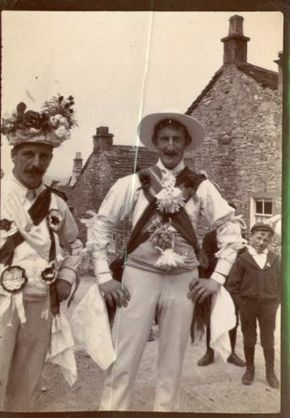Annotation:Winster Gallop: Difference between revisions
No edit summary |
No edit summary |
||
| (3 intermediate revisions by the same user not shown) | |||
| Line 1: | Line 1: | ||
{{TuneAnnotation | {{TuneAnnotation | ||
|f_annotation='''WINSTER GALLOP.''' English, Morris Dance Tune (4/4 time). G Major. Standard tuning (fiddle). AB (Barnes): AABB (Raven, Sweet, Wade). “Winster Gallop”, both dance and tune, were originally collected by | |f_annotation=[[File:Winstermorris.jpg|right|290px|thumb|Winster morris dancers at the time of Sharp's visit in 1908. Sharp's photographs were taken by T. Lennox Gilmour, leader writer and photographer on the Morning Post]]'''WINSTER GALLOP.''' English, Morris Dance Tune (4/4 time). G Major. Standard tuning (fiddle). AB (Barnes): AABB (Raven, Sweet, Wade). “Winster Gallop”, both dance and tune, were originally collected by [[wikipedia:Cecil_Sharp]] (1859-1924) when he visited the Derbyshire village of Winster in 1908. The first mention of the morris at Winster is in 1863, however, it was considered to have been well-established at the time. Morris dance teams have continued to perform at Winster to the present day, with hiatuses during the World Wars. | ||
<br /> | <br /> | ||
<br /> | <br /> | ||
Latest revision as of 00:15, 19 September 2021
X:1 T:Winster Gallop S:Claire McLaughlin, Edinburgh 9/4/03 Z:Nigel Gatherer M:2/4 L:1/8 K:G GB GB | GB d2 | AB/c/ BA | GB d2 |ce fe | dB d2 | AB/c/ BA | G2 G2 :| gf ed | gf ed | gf ed | cB A2 |fe d2 | fe d2 | d2 A>c | BG G2 :|]

A rather simple tune in its bare-bone state, it is frequently the first tune learned by beginning Northumbrian pipers, and indeed, in modern English sessions in general it is considered a ‘beginner’s tune’. It is sometimes compared with "Rakes of Mallow (The)." Nevertheless, the tune has had modern-era longevity, is considered part of the core repertory and has been recorded numerous times by well-regarded performers. The tune is used for either a polka or a single step in the North West (England) morris dance tradition, and has been characterized for session play as both as an ‘English reel’ and as a polka.
As is the custom, the basic melody is meant to be varied and embellished by the player to establish interest.

